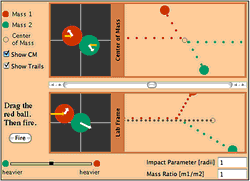![]()
![]()
Below is a half size image of what the Java Applet looks like after a collision:

The applet was run 12 times. In the laboratory frame of reference, i.e., ball #2's frame of reference, ball #2 is always at rest before every collision. So there is no initial trail of tracks for ball #2 in the lower perspective. In the frame of reference of the center of mass (the top perspective), both balls are moving before and after the collision. Four different relative mass balls were used (from the ball #1 being lighter at 0.4 times the mass of ball #2 to twice as heavy). The applet can be run with a greater difference in mass, but then some of the recorded track positions are too far apart to be measurable on the captured image.
While a head on
collision can be arranged, the rebounding track overlays the initial track making analysis difficult. As a result collisions were conducted with the incoming ball's center missing the target ball's center by from 0.65 to 1.8 radii. Larger off center collisions can be arranged, but the resulting motion leaves some marked locations too close together to measure. And collisions
at more than 2.0 radii are misses
with no collision occurring at all.
Each captured image has been nearly doubled in size to make the tracks easier to measure. Images are about 55KB in size so may require a few seconds to load. For that reason they have not all been presented at once, but instead presented in the table below so you can load one image at a time.
| amount collision was off center (in ball radii) | |||
| relative masses | 0.65 | 1.0 | 1.8 |
| m1 = 0.4 m2 | click to view | click to view | click to view |
| m1 = m2 | click to view | click to view | click to view |
| m1 = 1.7 m2 | click to view | click to view | click to view |
| m1 = 2.0 m2 | click to view | click to view | click to view |
Where should the tracks be measured? ...the distance between dots? ...from consistently the same part of each dot, say the leading or trailing edge? Note also that collisions may occur at some time between dots. So the distances just before or just after the collision may represent travel for only a fraction of a time interval. With the time of those fractional intervals not known, those intervals immediately before and just after the collision location should probably be ignored.
![]()
back to experiment III-3
to next experiment
to e-Physics menu
to site menu